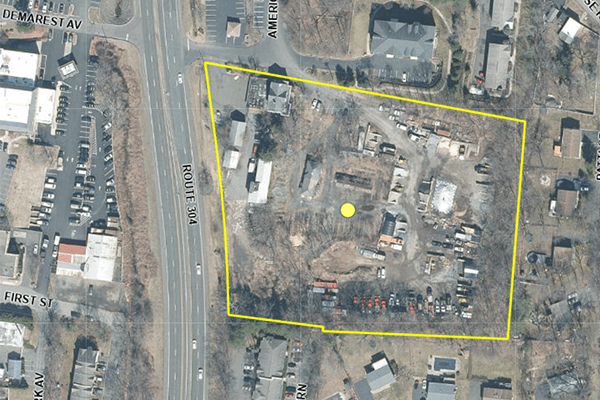|
RCBJ-Audible (Listen For Free)
|
Vanderbilt Grande Plan Includes Part Land Swap/Land Purchase For Swath Of Land To Make Long Path Contiguous; Senior Development Will Raze Former Historic Train Station
By Tina Traster
Clarkstown is gaining an important swath of open space but it’s losing the remains of an historic train station on Route 304. These two events are related.
A developer who has long desired to build senior housing on a five-acre parcel along Route 304 has traded an even larger parcel along Route 9W in Valley Cottage to bring the plan to fruition. As the project progresses, it has become clear that Jeff Weinberger, an applicant for the Vanderbilt Grande senior housing project, intends to bulldoze the vestiges of the former New City Branch train station that dates to the late 1800s.
While some preservationists bemoan the loss of another piece of history, members of the New York/New Jersey Trail Conference are thrilled that the last piece of privately-held land needed for a contiguous hiking trail along the Long Path will finally be realized.
Clarkstown resident Peter Grafstein last week at a Town Planning Board meeting via email urged members to hold off on greenlighting the application for a 100-unit development until something can be done to preserve the old New City train station building, which once served as the stop on the three-mile single track of the NJ and NY Railroad that ran between Nanuet Junction and New City until 1939. Others requested the station be disassembled and stored.
“The tracks are long gone but the remnants of the New City Station remain,” Grafstein wrote in a letter read aloud during the Planning Board hearing on the Vanderbilt Grande project. “This structure is the final piece of physical evidence of the New City Branch’s existence. Preserving the history of this period in Rockland history is vital to the region’s identity and image, so I am urging the local government to consider the restoration of this structure as a stipulation of the development of this property.”
Gil Heim, the Planning Board’s chairman, made it abundantly clear that that “train” had left the station.
“We looked into this 15 years ago,” said Heim, referring to an effort many years ago for a shopping center owner to have the train station relocated. “It couldn’t be done.” The Chairman did not offer any explanation as to why the preservation of the historic relic was not a contingency in the application, which has been submitted by Senior Housing Associates of Westchester, Inc.
The Planning Board also voted unanimously to accept a stipulation of the project that calls for a land in lieu of money swap that will require the Town of Clarkstown to pay the Weinbergers $125,000 for 7.7 acres on West Hook Mountain.
The Town Board is set to vote on the open space acquisition at its board meeting on Tues., August 22. By many accounts, the Town Board is expected to vote for the deal.
The town requires a developer to set aside land in multifamily developments for recreational use. Where land is unavailable, a developer can pay $4,000 per unit in lieu of land. The Weinbergers said they did not have land available to set aside, and rather than pay $400,000 to the town’s land trust, they made an arrangement to sell the town land on West Hook Mountain. However, because the parcel appraised for $525,000, the town has agreed to pay the developer $125,000 – the difference between the value of the parcel and the money that the developer was required to pay.
Town Planner Joe Simoes did call the arrangement “unusual” but said the town has long coveted that swath of land to make the Long Path safer and more contiguous for hikers who now must walk along Christian Herald Road and along the narrow shoulder of Route 9W.
“It’s a very exciting development,” said Marvin Baum, a Clarkstown resident and member of the New York/New Jersey Trail Conference. “The Long Path can finally be rerouted. This has been a dream for many for decades.”
The Planning Board on Wednesday voted unanimously to give the Weinbergers preliminary site approval for the Vanderbilt Grande plan. The proposed development is in the AAR Senior Housing zone, and calls for 100 rental units in four buildings set around a Village/Main Street. Three of the buildings will have 26 units each. The fourth building will have 22 units. Six of the units will be designated as “affordable.” Apartment unit sizes vary from 1116 to 1148 square feet with total habitable space between the four buildings and 100 units of 114,000 square feet. Also planned are a community room, pool, and garages for each unit. 250 parking spaces are planned.
The site at 41-47 Demarest Avenue housed a former lumber yard and hardware store. It was re-zoned an AAR (Active Adult Residential) community, which requires at least one resident in each apartment to be over 55. The zone does not allow persons under 18 to be permanent residents in the units.
Clarkstown’s zoning code has what is known as the AAR or Active Adult Residence zone, which allows a developer to apply to the town board for an overlay or floating zone allowance. The floating zone must be close to public transportation, shopping and community services. While an application can be considered in many of the town’s zones, the site must be a minimum of three acres or larger.
Last year, the Planning Board granted a negative SEQRA (State Environmental Quality Review Act) declaration to the applicant, sending it on to the Zoning Board of Appeals for variances. The developer secured variances for side yards, building height to 50 feet and maximum building coverage. Variances for minimum side yards were reduced from 50 feet to 35 feet. Total side yards were reduced from 100 feet to 78 feet. Maximum building height was increased from 35 to 50 feet. And, maximum building coverage from 20 percent of the lot to 27 percent.
The Town of Clarkstown has set limits on the number of senior housing units that can be built and has zoning designations for where they can be sited. In total, there is a cap of 1,500 units that can either be built by special permit or in the Active Adult Residential Zone (AAR).
The AAR zone was created back in 2007 as a floating zone that can be overlayed over a variety of other zones. Requirement include proximity to public transportation, lots of three acres or more, and only 800 units are allowed town-wide.















